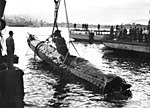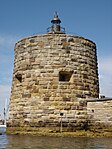Garden Island Tunnel System

The Garden Island Tunnel System, also known as Garden Island tunnels, Garden Island Tunnel Complex and Potts Point Tunnels, is a former tunnel warfare system in Garden Island, Sydney, Australia. Used in World War II by the Royal Australian Navy in 1941, the tunnels were dug from sandstone beneath Potts Point after the Japanese attacked Pearl Harbor, to shelter the men working at the naval base from air raids. Some of the tunnels feature names such as Petticoat Lane (named after London's landmark), North-West Passage and Lambeth Walk.The tunnel system featured a power station, a command centre, offices and air raid shelters. Today, the tunnels and chambers are used for electrical wiring and communications.
Excerpt from the Wikipedia article Garden Island Tunnel System (License: CC BY-SA 3.0, Authors, Images).Garden Island Tunnel System
Wylde Street, Sydney Potts Point
Geographical coordinates (GPS) Address Website Nearby Places Show on map
Geographical coordinates (GPS)
| Latitude | Longitude |
|---|---|
| N -33.85965 ° | E 151.22871 ° |
Address
Garden Island
Wylde Street
2011 Sydney, Potts Point
New South Wales, Australia
Open on Google Maps











